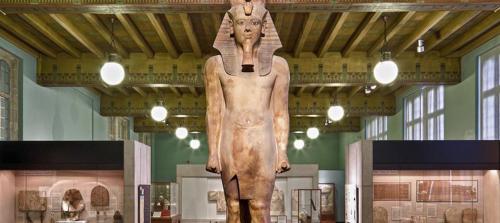Last week I attended the annual meeting of CIPEG (International Committee for Egyptology, ICOM) at the Oriental Institute of the University of Chicago thanks to a travel grant provided by the Art Fund. The four-day meeting was focused on ‘The Role of Curators in Museum Research and Exhibits: Tradition, Change, and Looking to the Future’ and was a valuable opportunity to share insights into the presentation of ancient Egyptian and Sudanese material in museum contexts worldwide. The Oriental Institute was the perfect setting, with an impressive Egyptological collection derived from many of the same sites as material now in Manchester. The programme also included visits to the Egyptian Consulate and Chicago’s vast Field Museum.

A restored colossus of Tutankhamun (reused by Aye & Horemheb) overlooks the galleries at the Oriental Institute
I gave a paper about our work here using new ways of engaging visitors during our award-winning ‘Animal Mummies Revealed’ exhibition tour, emphasising the importance of ‘in-person’ research and presentation (such as our ‘Mummy Re-Rolling’ events) and the (often underestimated) role of the curator as a performer and animator. I also spoke about the experience of working with Syrian artist Zahed Taj-Eddin on his installation ‘Shabtis: Suspended Truth’. Zahed’s work juxtaposes ancient material culture with modern political commentary to powerful effect. Using such contemporary art as a way to approach the contentious subject of modern migration in Europe seemed to strike a particular chord with colleagues in other institutions that did not normally address such issues.

Partly restored paste-inlay relief of Prince Nefermaat in the OI; another section of this unusually decorated chapel is in Manchester
Other papers included reports on upcoming exhibitions and ongoing research projects; a particularly promising update concerned a proposed archival photography installation at the site magazine in Tanis in the north eastern Delta, with the aim of opening dialogue with local people. A very useful panel session, with speakers drawn from a variety of curatorial backgrounds, focussed on the main themes of the conference. Despite the obvious diversity of modern curatorial roles – which seemed to have more to do with the size of an institution than anything else – participants were united by a common enthusiasm to share Egyptology with others. The vexed question of the display of human remains – focusing on research in Leiden, where the Rijksmuseum no longer shows unwrapped mummies – received some lively debate. Perhaps of interest to students wishing to pursue a career in museum Egyptology, there was no consensus on the necessity of museological training for curators, with some advocating on-the-job training for Egyptologists while others favoured specific study of museological methods to enable (for example) effective drafting of interpretation text.

Participants of CIPEG 2017
CIPEG is a unique forum for discussion, with shared challenges across national borders and sizes of institutions. In the context of the threat to sites in Egypt to supply the black market in antiquities, the General Assembly of CIPEG’s endorsement of the recent ‘Florence Declaration’ on cultural heritage seemed particularly important. Increasingly, curators are challenging the colonial context of many collections (especially through the use of archival material) and even questioning the modern construction of a monolithic ‘Ancient Egypt’ itself. It remains to be seen to what extent new thinking and results in academic Egyptology can filter through to interpretation that museum visitors will actually engage with.
The next meeting of CIPEG will, for the first time in the UK, be held at Swansea’s Egypt Centre in September 2018.

